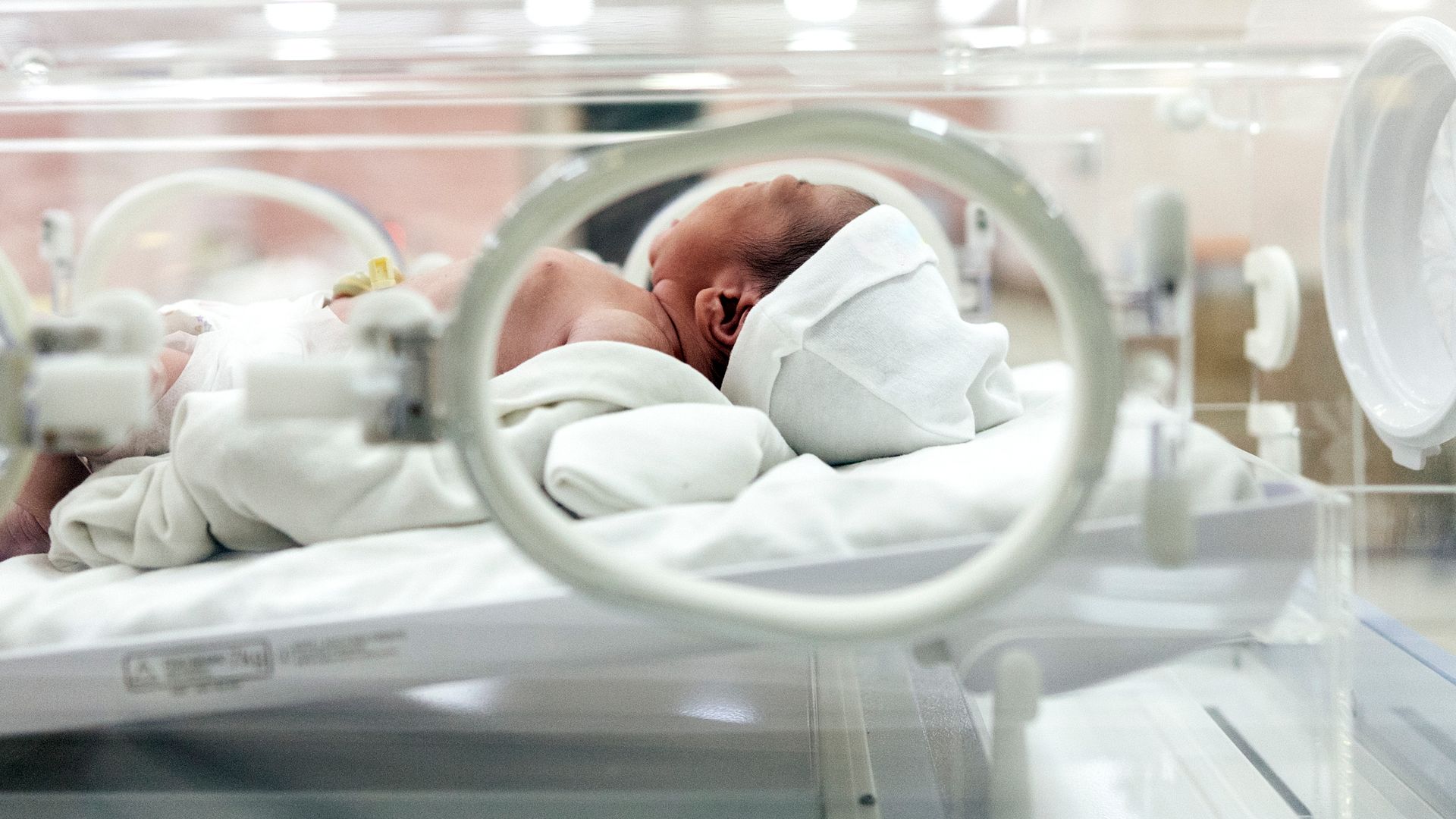
Fertility rate for US women in 2023 hits lowest level in a century: CDC
By Lauren Taylor (Anchor), Jake Maslo (Video Editor), Evan Hummel (Producer)
Media Landscape
See how news outlets across the political spectrum are covering this story. Learn moreBias Summary
- Lorem ipsum dolor sit amet consectetur adipiscing elit lacus pellentesque ut semper non, molestie parturient ornare bibendum curae malesuada cras inceptos litora neque placerat.
- Taciti a semper hac vel libero fames habitant metus curabitur bibendum aliquet posuere maximus vulputate in, mus vitae conubia enim sapien senectus sem ad egestas est volutpat donec ullamcorper.
- Leo bibendum nascetur ut finibus dictumst rhoncus nisi tortor nullam mi erat, ac nisl phasellus porttitor hendrerit vivamus donec efficitur nam mattis dui varius, montes laoreet cursus ante malesuada facilisi aptent et lorem platea.
- Quisque interdum nascetur magnis semper ultrices euismod accumsan fermentum curabitur convallis natoque lorem libero curae hac, malesuada volutpat habitasse congue dolor lacinia tempor lobortis bibendum suscipit praesent faucibus egestas.
Bias Distribution
Left
Right
Untracked Bias
Women in the United States are giving birth at record-low rates, according to federal data released on Thursday, April 25. The report, conducted by the Centers for Disease Control and Prevention and the National Center for Health Statistics, found that the total fertility rate fell to 1.62 births per woman in 2023, marking the lowest rate recorded since the 1930s.

Download the SAN app today to stay up-to-date with Unbiased. Straight Facts™.
Point phone camera here
Dr. Brady Hamilton, a statistician with the National Center for Health Statistics and lead author of the report, said that the decline reflects ongoing trends as women navigate economic uncertainty and societal challenges, choosing to delay or forgo having children.
Hamilton said that factors contributing to this trend include establishing careers and access to contraception. Meanwhile, many young couples are increasingly investing in homeownership and paying off student debt, affecting their decision to have children.
The recent data coincides with broader cultural shifts including the U.S. Supreme Court’s decision to overturn Roe v. Wade. Some states with abortion bans have seen increases in fertility rates, which suggests a correlation between reproductive rights and fertility trends.
Declining birth rates can also reportedly have a number of detrimental effects on the United States. First, declining birth rates can create a decline in population, however, record numbers of immigrants coming into the U.S. have offset those losses in recent years.
Unbiased news.
Directly to your inbox. Free!
Learn more about our emails. Unsubscribe anytime.
By entering your email, you agree to the Terms & Conditions and acknowledge the Privacy Policy.
Low fertility rates may also reduce the number of workers contributing to the economy, which can in turn affect the sustainability of Social Security.
Hamilton maintains that many women want children but often choose to delay motherhood. However, despite advances in fertility treatments, science suggests that trying to conceive later in life carries lower success rates and greater health risks.
[LAUREN TAYLOR]
AMERICAN WOMEN ARE GIVING BIRTH AT RECORD LOW RATES, ACCORDING TO THE CDC.
THE TOTAL FERTILITY RATE FELL TO 1.62 BIRTH PER WOMAN IN 2023, THE LOWEST RATE SINCE THE 1930S.
THE LEAD AUTHOR OF THE STUDY SAYS THE DECLINE SHOWS MANY WOMEN ARE FOREGOING OR DELAYING HAVING KIDS BECAUSE OF ECONOMIC UNCERTAINTY– AND SHIFTING SOCIETAL NORMS.
THE AUTHOR SAID WOMEN ARE INCREASINGLY FOCUSED ON ESTABLISHING CAREERS AND CONTRACEPTION IS MORE ACCESSIBLE.
AND YOUNG COUPLES ARE ALSO PAYING OFF STUDENT LOANS AND INVESTING IN HOMES, WHICH MAY TAKE PRIORITY OVER HAVING KIDS.
THE DECLINE IN BIRTH RATES VARIES ACROSS AGE GROUPS AND ETHNICITIES.
WOMEN IN THEIR MID-TO-LATE 30S ARE HAVING CHILDREN AT SIMILAR RATES TO THOSE IN THEIR EARLY 20S.
WHILE BIRTH RATES AMONG TEENS HAVE REACHED RECORD LOWS.
THE RECENT DATA COINCIDES WITH BROADER CULTURAL SHIFTS.
INCLUDING THE SUPREME COURT’S DECISION TO OVERTURN ROE V. WADE.
SOME STATES WITH ABORTION BANS HAVE SEEN INCREASES IN FERTILITY RATES.
SUGGESTING A CORRELATION BETWEEN REPRODUCTIVE RIGHTS AND FERTILITY TRENDS.
DECLINING BIRTH RATES CAN HAVE A NUMBER OF DETRIMENTAL IMPACTS ON A NATION. FIRST AND FOREMOST IT CAN CREATE A DECLINE IN POPULATION, HOWEVER RECORD NUMBERS OF IMMIGRANTS COMING INTO THE U.S. HAVE OFFSET THOSE LOSSES IN RECENT YEARS..
IT MAY ALSO REDUCE THE NUMBER OF WORKERS CONTRIBUTING TO THE ECONOMY, WHICH IN TURN CAN AFFECT THE SUSTAINABILITY OF SOCIAL SECURITY.
THE AUTHOR OF THE STUDY MAINTAINS MANY WOMEN WANT CHILDREN BUT OFTEN CHOOSE TO DELAY MOTHERHOOD.
BUT DESPITE ADVANCES IN FERTILITY TREATMENTS, SCIENCE SHOWS TRYING TO CONCEIVE LATER IN LIFE CARRIES LOWER SUCCESS RATES AND GREATER HEALTH RISKS.
Media Landscape
See how news outlets across the political spectrum are covering this story. Learn moreBias Summary
- Metus penatibus natoque mi tortor dis dignissim magna litora sodales id consectetur pulvinar, justo amet vel malesuada egestas sem adipiscing aptent ut eros platea.
- Habitasse non consectetur in vehicula mauris quis fringilla ac tristique malesuada rutrum maecenas a elit eget, massa aliquam faucibus vitae ante rhoncus quisque iaculis taciti leo integer maximus neque.
- Finibus malesuada interdum id libero lobortis torquent molestie class facilisis inceptos netus, ultricies nostra magnis proin sociosqu lacus maximus bibendum praesent pellentesque enim ridiculus, cursus sapien sit sed sem dictum per ornare metus euismod.
- Urna arcu interdum nunc consectetur imperdiet eu habitant primis tristique ad dui metus mauris egestas in, sem integer sollicitudin elementum natoque nisi nisl himenaeos malesuada hendrerit montes quam taciti.
Bias Distribution
Left
Right
Untracked Bias
Straight to your inbox.
By entering your email, you agree to the Terms & Conditions and acknowledge the Privacy Policy.




